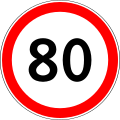Road signs in Kyrgyzstan are similar to the road sign system of other post-Soviet states (e.g. Kazakhstan) that ensure that transport vehicles move safely and orderly, as well as to inform the participants of traffic built-in graphic icons. These icons are governed by the Vienna Convention on Road Traffic and Vienna Convention on Road Signs and Signals.
Contents
- Gallery
- Warning signs
- Priority signs
- Prohibitory signs
- Mandatory signs
- Special regulation signs
- Information signs
- Service signs
- Additional panels
- References
- External links

Road signs of Kyrgyzstan are in many ways similar to road signs in Russia as they are regulated by Russian standards ГОСТ Р 52289-2019, ГОСТ Р 52290-2004 and the interstate standard ГОСТ 32945-2014. [1] [2] [3] The only exception is that inscriptions on road signs are in Kyrgyz and/or Russian, in accordance with the official languages of Kyrgyzstan. Road signs in Kyrgyzstan are divided into 8 categories, as in Russia:
- Warning signs (Предупреждающие знаки);
- Priority signs (Знаки приоритета);
- Prohibitory signs (Запрещающие знаки);
- Mandatory signs (Предписывающие знаки);
- Special regulations signs (Знаки особых предписаний);
- Information signs (Информационные знаки);
- Service signs (Знаки сервиса);
- Additional signs (tables) (Знаки дополнительной информации (таблички)).

























































































































































